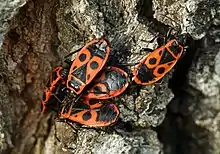Pyrrhocoricin
Pyrrhocoricin is a 20-residue long antimicrobial peptide of the firebug Pyrrhocoris apterus.[1]
| Pyrrhocoricin | |||||||
|---|---|---|---|---|---|---|---|
 The firebug Pyrrhocoris apterus | |||||||
| Identifiers | |||||||
| Symbol | ? | ||||||
| CAS number | |||||||
| PDB | 5FDV | ||||||
| UniProt | P37362 | ||||||
| |||||||
Structure and function
Pyrrhocoricin is primarily active against Gram-negative bacteria. The peptide is proline-rich with proline-arginine repeats, as well a critical threonine residue, which is required for activity through O-glycosylation. Like the antimicrobial peptides drosocin and abaecin, pyrrhocoricin binds to the bacterial protein DnaK, inhibiting cell machinery and replication.[2] Only the L-enantiomer of pyrrhocoricin is active against bacteria.[3] The action of pyrrhocoricin-like peptides is potentiated by the presence of pore-forming peptides, which facilitates the entry of pyrrhocoricin-like peptides into the bacterial cell.[4] Proline-rich peptides like Pyrrhocoricin can also bind to microbe ribosomes, preventing protein translation.[5] In the absence of pore-forming peptides, pyrrhocoricin is taken into the bacteria by the action of bacterial uptake permeases.[6]
References
- Rosengren KJ, Göransson U, Otvos L, Craik DJ (24 February 2019). "Cyclization of pyrrhocoricin retains structural elements crucial for the antimicrobial activity of the native peptide". Biopolymers. 76 (5): 446–58. doi:10.1002/bip.20159. PMID 15478127.
- Zahn M, Berthold N, Kieslich B, Knappe D, Hoffmann R, Sträter N (July 2013). "Structural studies on the forward and reverse binding modes of peptides to the chaperone DnaK". Journal of Molecular Biology. 425 (14): 2463–79. doi:10.1016/j.jmb.2013.03.041. PMID 23562829.
- Kragol G, Hoffmann R, Chattergoon MA, Lovas S, Cudic M, Bulet P, Condie BA, Rosengren KJ, Montaner LJ, Otvos L (September 2002). "Identification of crucial residues for the antibacterial activity of the proline-rich peptide, pyrrhocoricin". European Journal of Biochemistry. 269 (17): 4226–37. doi:10.1046/j.1432-1033.2002.03119.x. PMID 12199701.
- Rahnamaeian M, Cytryńska M, Zdybicka-Barabas A, Dobslaff K, Wiesner J, Twyman RM, Zuchner T, Sadd BM, Regoes RR, Schmid-Hempel P, Vilcinskas A (May 2015). "Insect antimicrobial peptides show potentiating functional interactions against Gram-negative bacteria". Proceedings. Biological Sciences. 282 (1806): 20150293. doi:10.1098/rspb.2015.0293. PMC 4426631. PMID 25833860.
- Florin T, Maracci C, Graf M, Karki P, Klepacki D, Berninghausen O, Beckmann R, Vázquez-Laslop N, Wilson DN, Rodnina MV, Mankin AS (September 2017). "An antimicrobial peptide that inhibits translation by trapping release factors on the ribosome". Nature Structural & Molecular Biology. 24 (9): 752–757. doi:10.1038/nsmb.3439. PMC 5589491. PMID 28741611.
- Narayanan S, Modak JK, Ryan CS, Garcia-Bustos J, Davies JK, Roujeinikova A (May 2014). "Mechanism of Escherichia coli resistance to Pyrrhocoricin". Antimicrobial Agents and Chemotherapy. 58 (5): 2754–62. doi:10.1128/AAC.02565-13. PMC 3993218. PMID 24590485.